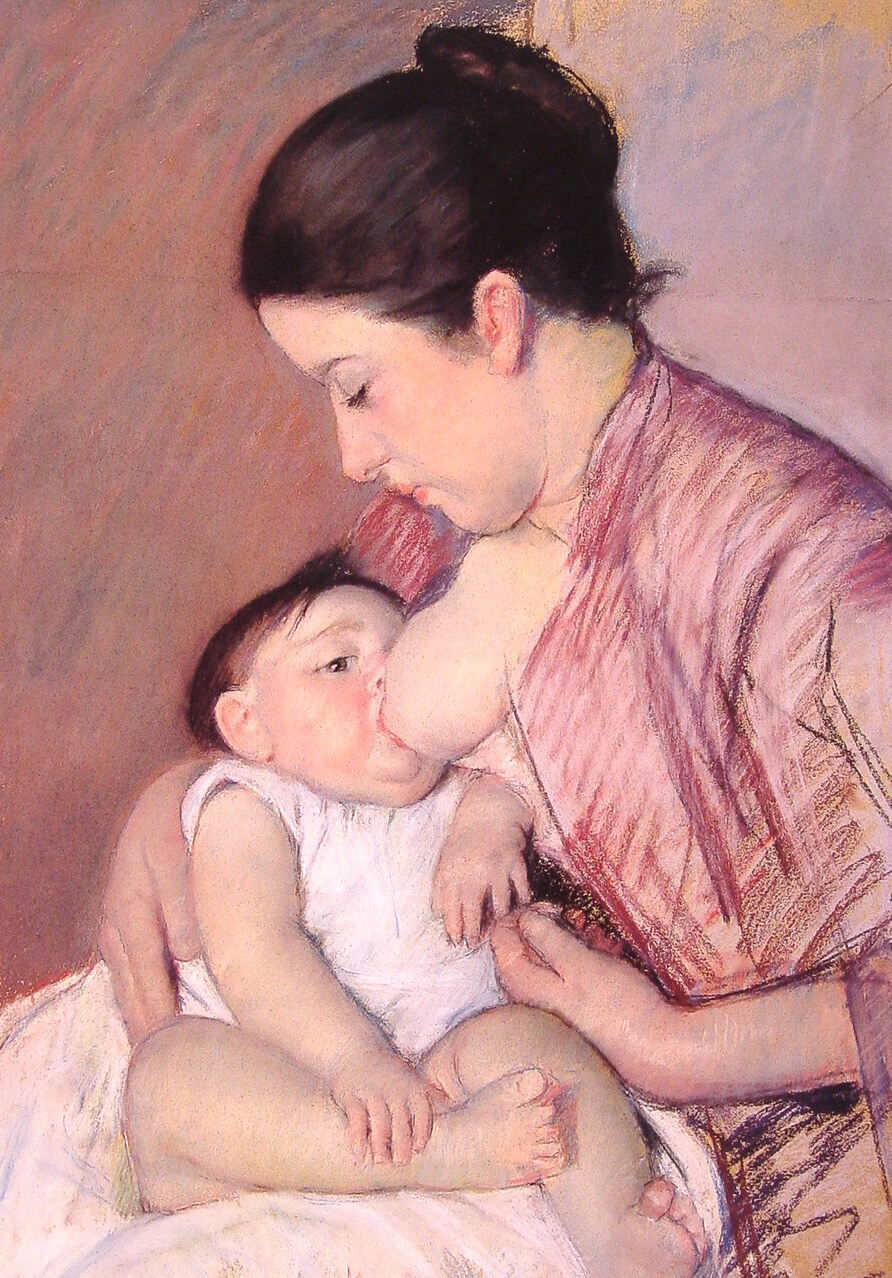
The Neglected Value of Breastfeeding
by Eliza Samways
“Breastfeeding is work. It takes time, effort, and skill. And it has immense economic value. Yet, breastfeeding women aren’t being recognised as contributing to the economy, whereas formula is.”
~ Dr. Phillip Baker
“We are the only mammal that does not trust in our body’s ability.”
~ Ina May Gaskin
Breastfeeding is a natural process by which mammalian mothers provide food, comfort, safety and development for their children. Breastfeeding in humans gives babies a jumping-off point to become accustomed to the outside world, kickstart their immune system and build the beginnings of human relationships. Breast milk is a constantly adapting food that allows for both mother and child to recover and bond after the birth. While it is the natural form of nourishment, breastfeeding their baby can be an emotionally and physically taxing journey for mothers, leading some to opt for formula instead.
Formula is a breast milk replacement. Formula is very good at what it is designed to do – feed babies. However, it can’t provide the vast concoction of antibodies, the safe haven, and the attachment that comes with breastfeeding. There are, of course, medical complications that can prevent the mother from attempting to breastfeed or from carrying on after having started. Breastfeeding is by no means a pain-free, easy process, and a mother or child can also have conditions, illnesses or intolerances that complicate, and altogether prohibit, breastfeeding. While I am by no means against formula, and can see its purpose and uses, I want to focus on the social influences and factors of why 83% of women in the UK, 43% in Spain, and 44% globally, stop breastfeeding after three months, and why only 1% in the UK and 35.2% in Spain continue to breastfeed after six months (68% globally continue for at least one year). This is despite the World Health Organisation’s recommending at least six months of breastfeeding, with two years being the ideal.
It is my experience that many women choose not to start or carry on breastfeeding because they lack the support of a community around them and the knowledge of how and why to breastfeed. There is a severe deficit of support and information in the existing healthcare systems. Support is not given to mothers who are struggling with the physical pain and the emotional uncertainty of the breastfeeding journey. Doctors have been known to offer formula as a solution, rather than investigating the root cause of the challenges a mother might be having.
There are independent health consultancies and NGOs for extra support, but the burden is on the mother to go and find these resources, and women often do not have the tools, support or knowledge to find them. Given the barrage of advertising and the economic incentives around convincing mother to feed their baby with formula, it is incredible that sore, sleep-deprived, and worried mothers are able to make the right decision for themselves.
I want more mothers to breastfeed – not only because of the lifelong bond created between mother and child, but because of how easy it can become with the right knowledge and guidance once the first hurdles are overcome. More mothers should be aware of the benefits, the possibilities, and the fact that there are solutions to their concerns and doubts.
Breastfeeding is more than a way of keeping the baby alive (a label that could easily be applied to formula-feeding). It creates a deep emotional bond between the mother and child, giving the baby intimacy and relational cues that the child takes into adulthood, shaping behaviour and emotional well-being. It can also teach the mother patience and ways of communicating with her child, providing emotional benefits for her too. This is more than keeping the baby alive, this is helping them thrive.
Breastfeeding is shown to have benefits and rewards for both mother and baby, even long after it is finished, both physically and emotionally. It helps the mother lose post-birth weight, regulate her water retention, and helps in contracting the womb after birth. It also reduces the risk of high blood pressure, type-2 diabetes, and breast and ovarian cancer – among other illnesses – over her entire life. Breastfeeding allows the baby to receive a range of antibodies from their mother. If the mother is sick, her milk will adjust to carry antibodies, so that the baby can receive them and won’t get ill. Breastfed babies have a lower risk of asthma, type-2 diabetes, and sudden infant death syndrome (SIDS), as well as other life-changing and fatal diseases. Furthermore, while they still in infancy, they are also less likely to get ear infections or stomach bugs, along with other illnesses.
The consistency and content of breast milk changes, not only will it be different for each baby – specifically adapted to their needs and developmental changes, but it will change within each day. For instance, breast milk produced at night contains more melatonin to help a baby sleep better. For a baby girl, the milk will contain more calcium so that support faster bone development and an earlier puberty.
On an emotional level, breastfeeding encourages the mother to rest and recover after giving birth. Breastfeeding allows the mother to sit and bond with her child, taking the time to adapt and reflect. It creates a safe and stable safe environment for the baby during the so-called “fourth trimester” – a time when the infant doesn’t yet realise they are separate from their mother. This sense of security builds confidence and gives the baby assurance that they have a space to grow and develop, with long-lasting effects.
Of course, as previously noted, milk replacements are sometimes vital and necessary. I know people who, due to surgery or health issues, have been unable to breastfeed. In these cases – and many more – formula is a very valuable alternative. We are fortunate to live in a time when we can prevent the transmission of diseases, provide nutrition to babies whose mothers cannot breastfeed, and ultimately save lives.
However, in promoting breastfeeding, much more can be done so that mothers who are physically and medically able are not discouraged by social or institutional pressures – whether from medical staff, family, peers, or workplaces. They should be encouraged to believe in their bodies’ capabilities and innate wisdom. Health professionals could take more time to explore root issues, rather than recommending formula as a default and easy fix. Families could be more open to a mother’s questions and preferences. Society could become more accepting of breastfeeding in public. And more widespread understanding of the benefits and necessity of breastfeeding could empower mothers to persist.
If current attitudes toward breastfeeding are allowed to perpetuate, then community support and the knowledge that mothers need to engage in breastfeeding will continue to stagnate with them. This would increase the risks of babies developing health conditions, weaken the mother-child bond, and ultimately affect wider society. It would also rob women of the chance to discover the strength and capability within themselves – to realise that their bodies and instincts are more powerful than they may have thought.
In conclusion, mothers – and others – should learn about the benefits of breastfeeding and support women in breastfeeding their children – if they are able – for the good of their children and themselves.

Latest Articles
- The Neglected Value of BreastfeedingOn the benefits of breastfeeding
- Architecture Without a FutureOn architectural historicism
- The Absurdity of the EverydayOn seeking and creating meaning
- Bridging Science and SocietyOn interdisciplinary collaboration
- Renewable Baseload PowerOn the future of energy
- AI and the Battle for CommunicationOn control of communication
- Operating in a Bitcoin WorldOn the new monetary order
- Beyond Political NostalgiaOn hope as a political force
- The New Age of CaesarsOn the end of liberal democracy
- Social Media: Five Stages of GriefOn reclaiming our attention
About the author
Eliza Samways is an administrator, mother, wife, global development graduate, and language enthusiast. Since becoming a mother, she has trained as a breastfeeding counselor to support mothers on their motherhood and breastfeeding journeys. She takes a holistic view of motherhood and is passionate about the importance of community, sharing knowledge, and supporting each other. In her spare time, she exercises, reads, and knits.
Updates
Sign up to the CATALYST Updates Substack to receive the monthly schedule for new articles, news on the physical print-run of CATALYST’s inaugural issue, and details on the upcoming CATALYST Conference.


